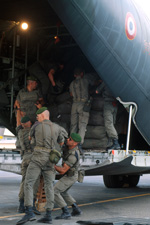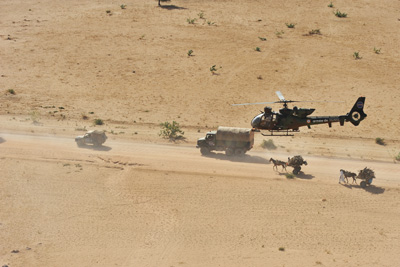LOGISTICS ON THE FRONT LINE (I)
A few months ago, SLD sat down with General Jean-Pierre Bansard, in charge at the time of Logistics Organization within the MoD Chief of Staff, in order to gain a better understanding of the evolution of French support and logistics in light of the many undergoing reforms and the mutation of the battlefield.
This is the first of a three-part series previously published in French as a single article in “Soutien Logistique Défense” in October 2009.
***
1. [SLD] Could you highlight the main points, both qualitative and quantitative, regarding the current massive logistics reform within the French armed forces?
[General JP Bansard] The reform of the French armed forces, which is now taking place is at least as thorough as the professionalization reform initiated in 1996. This reform is twofold as it results from the convergence of two distinct reviews: on the one hand it stems from the White Paper on defense and security and on the other hand from the General Review of Public Policies (known as “RGPP” in French).
The White Paper was meant to adapt the format and structure of the armed forces to the evolution of the geostrategic environment, whereas the RGPP aimed to rationalize the entire support functions within the Ministry of Defense. Because logistics is part of both the operational and the support missions, it stands at the very heart of the current reforms.
2. What results are you expecting from this reform in terms of budget savings, operational efficiency and under which expected timeline?

The main objective of the current reform is to achieve savings in Operation and Maintenance (O&M) in order to redirect investment towards procurement and increase the modernization of our military capabilities.
Reforms will be carried out during the 2009-1014 Program Law. Over the course of this period, 54,000 jobs will be removed, for the most part from the support units (around 72%). At the end more than 4 billion Euros are expected as far as savings in O&M are concerned, including the costs induced by the reform process itself (such as for instance job loss compensations). We must however deduct 1.4 billion Euros in procurement, mainly because of infrastructure costs which are estimated to be worth 1.3 billion Euros (these figures are detailed in the February 2009 National Assembly report by Mr. Cazeneuve and Mr. Cornut-Gentille). Beyond 2014, the recurring savings in O&M should reach 1.5 billion Euros a year.
3. What is the impact of the new strategic outlook mapped out by President Sarkozy and its government (reduced presence in Africa; stronger commitment in Afghanistan; new base in the UAE; reintegration in NATO) on logistics?
– How can we, for instance, compensate for the diminution of our traditional logistics support bases in Africa?
The French White Paper does plan for a restructuring of our military presence in Africa. However, decisions will only be made once the agreements binding us with African hosting nations will have been reviewed on a case-by-case basis. It is therefore a bit premature to accurately describe the logistics organization we shall adopt in the future. It is, in any case, already certain that we shall continue to be granted permission to several access points, which may prove necessary in case of a required force projection. Indeed, we are currently working on the establishment of a new permanent base in the United Arab Emirates, which will complement our setting in a region of strategic importance. The reduction of our pre-positioned forces has been rendered possible by two major factors:
-
the enhancement of our ability to anticipate crises thanks to new upcoming “knowledge and anticipation” capabilities;
- the reactivity of our intervention forces, which need to be able to depend on the appropriate projection means in order to deploy in specific timelines.
Our pre-positioning at sea, via in particular our projection and command ship (what we refer to, in French, as BPC, for Bâtiments de projection et de commandement) is indeed quasi permanent. We must also be in a position to be able to rely on rapid strategic and tactical power projection means: from this point of view, the A400M is crucial, especially as far as deployments on the African continent are concerned, since the C17 cannot easily be deployed in this type of terrain.
– Has the Afghan experience been changing our traditional modus operandi as far as support and logistics are concerned?
Afghanistan is currently the operational area, which shows itself to be the most challenging for logisticians. This theater of operation is especially tough as far as geography is concerned, with enclaves only connected via rare and difficult lines of communication, which are considered especially dangerous because of hostile activity (mines, traps, ambushes…).
We already faced similar situations in ex-Yugoslavia – with a somewhat lower threat level though – as well as on African theaters. Of course, this type of theater – in which frontlines are non-existent, where, as a result, it is hard to identify any front or rear areas, and where the location of the forces to be sustained are divided by zones of insecurity – represents a permanent challenge for the logisticians, who must ensure the constant delivery of crucial supplies to the troops.
We had to draw the right conclusions via our traditional lessons learned process at three levels:
- regarding the equipment, especially as far as new protection requirements are concerned (armoring of the cabins of logistics vehicles; reconfiguration of our light armored vehicles – VAB for Véhicules de l’avant-blindé – and enhanced anti-IED protection);
- regarding the modes of transportation, which asked for a more frequent use of air-mobility and air-transport;
- and, finally, on processes, which required a close cooperation between logistic operations and tactical operations and a perfect coordination of overall maneuvers.
Indeed, the existence of a compartmentalized theater and the absence of distinct front and rear areas are placing the logisticians on the frontline, an observation already made during the war in ex-Yugoslavia. Adjustments had therefore to be made concerning the logisticians’ training, which has become more military, in order to better adapt to the new environment. In this type of theaters, the logisticians’ missions are totally integrated with those of the warfighters (escort mechanics, roads’ opening, equipment protection; etc…). Air assets are also mobilized to the benefit of logistics: air transport of course, but also fighter aircrafts at times, mostly for reconnaissance missions as well as close air support when attacked.

– Will more projection capabilities be required?
In terms of projection capabilities, the White Paper’s new operational contract takes into account the increase in warning time which is expected from improved crisis anticipation.
This in turn should allow us to recover part of the military support capabilities which are deployed in stabilized, or soon-to-be stabilized, theaters, and re-deploy them in a new theater where they will be better used.
At the same time and in order to facilitate such a redistribution of support capabilities, we have been implementing since 2006 the addition of new assets through outsourcing and the use of local manpower on stabilized theaters. This concept, called CAPES France, is similar to the one put in place in the United States (LOGCAP), in Canada (CANCAP), in the United Kingdom (CONDO-CONLOG) and within NATO. The first conclusion, after three years of joint experimentation in ex-Yugoslavia and in Chad, mostly in strategic transport (by sea, air and ground) and the support of the warfighter, is that important savings were made in ex-Yugoslavia. In Africa, where the local work force has always been directly employed by the armed forces, the CAPES outsourcing experience proved to be less conclusive at first sight: such an observation needs however to be balanced out by the fact that the tasking requested from the contractors tends to be more demanding than back home, which makes it hard to compare. Outsourcing in Afghanistan seems more problematic because of the high threat level which is constant, except for a few rare secured areas. For example, convoys coming from Pakistan move along in risky conditions: it is the case for military convoys, but even more so for civilian truck drivers who enjoy no protection.
– Are new types of complementarities within the EU and NATO being considered?
Whether in NATO or the EU, there is no doubt that logistics capabilities are among the toughest to assemble in the context of a multinational operation surge.
NATO has developed relevant concepts and processes to build up logistics multinational capabilities. However, one should stress that no single country hurries to play the role of logistics expert or leading nation (“nation cadre” in French). This stems from multiple reasons, among which is the negative ratio between the heavy costs embedded in the mobilization of the necessary capabilities and the low political visibility of logistics compared to combat.
France does however participate actively in these multinational initiatives, by taking on an important role in logistics (i.e. France’s role as the leading nation in the framework of the European force deployed for Darfur).
The solution certainly lies in the amendment of funding regulations in order to make the supply of support capabilities more attractive. In the meantime, outsourcing is often the way out of stalemates, at least for theaters and operations for which this kind of solution can be considered. Another major advantage of outsourcing is that it also allows to solve potential interoperability issues, which can often be extremely problematic when logistics support missions have to be implemented.
———-
***Posted February 8th, 2010


